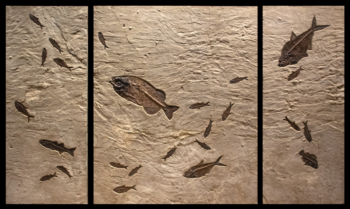 The exhibit features fifty-million-year-old stone artworks from the Green River Formation in Wyoming, on display in Chelsea’s gallery district.
The exhibit features fifty-million-year-old stone artworks from the Green River Formation in Wyoming, on display in Chelsea’s gallery district.At the Wilensky Gallery, all of nature is viewed as one continuous evolving work of art. It is within this concept that ancient fossils are included in the conversation of the gallery’s revolving exhibitions. Opening on May 9th, and running through August 3rd, 2019, “Ancient Treasures: Fossils from The Eocene,” will feature twenty-five fossils meticulously removed and preserved by the Green River Stone Company, one of the world’s leading experts in fossil excavation and preservation. Long-forgotten creatures from Wyoming will appear as impressions in the Chelsea art gallery, similar in appearance to an etching or print, with fish or crocodiles pressed onto a stone.
Prehistoric objects, such as fossils, have traditionally been reserved to the realm of science, natural history museums and deserts in remote parts of the world. The upcoming New York show will provide an opportunity for art buyers to add these extraordinary, natural art objects to personal collections, and will allow enthusiasts to view some of the rarest never before seen fossils originating in the United States.
“When standing in front of these breathtaking works one quickly makes the transition from historical artifacts to a most powerful visual art form. Our clients naturally begin comparing elements of color, composition, texture, and beauty, the visual elements of great art. Beyond the physical beauty of these works, one is struck by the reality of their age and the passage of time. Not in the sense of days, weeks, or years as we are accustomed, but in tens of millions of years, the time required to transform living creatures into solid stone,” says Douglas Miller, a Partner at Green River Stone Company.
The exhibition will feature a variety of natural art murals, including a 50-million-year-old paddlefish, which was once thought to be the rarest fossil in the Green River Formation. Part of the reason Paddlefish fossils are so rare is that like their close relative, the sturgeon, their axial skeletons are composed largely of soft tissues that do not preserve in fossils. The particular specimen which will be displayed contains exceptional detail, with fine bones in the fin and tail regions, as well as the small stellate bones in the Rostrum, or bill. Another noteworthy showing is the Triptych Fish Mural, a three-part fish mural featuring a flowing composition of 26 fossil fish on a dark, highly figured, limestone matrix.
Stuart Wilensky, President of Wilensky Fine Minerals, says, “Lithography is essentially printing with stone. These fossils have imprinted themselves directly onto the very same limestone used in the earliest lithography. The dark delicate bones and skin graphically reveal themselves against the fine-grained buff colored limestone, appearing so similarly to a lithographic stone that one must wonder if this was how the concept came to the inventor, Alois Senefelder, in 1796. These random arrangements of ancient fish, turtles and palms are the very truth of life, much like the Momento Mori art so popular during the Middle Ages and the Renaissance. The fossils themselves are the ultimate visualization of this symbolism—‘remember you must die.’ This concept has been central to art, literature, and philosophy throughout history. To look at these fossils, one cannot help but contemplate the vanity of life, and the transient nature of all things. Fossils bring this to an artistic level that only nature itself can accomplish.”
The uplifting of the Rocky Mountains in the Tertiary period created the Green River Formation, with its diverse range of remarkably well-preserved faunal and floral fossils. In Southwestern Wyoming, fossil-rich calcium carbonate shale was deposited as sediment in a complex of freshwater lakes during the Eocene era around 50 million years ago. Green River is best known for its exquisite fish fossils, which were first discovered in this area during the 19th century. The excellent preservation is attributed to the great depth of the lakes and the anoxic conditions, which would have prevented scavengers from disturbing the dead fish, plants and reptiles. The Green River Stone Company has a private quarry in Wyoming, and a laboratory in northern Utah for preparing the fossils, and has been quarrying and preparing exquisite fossils for over twenty years. The company’s fossils can be seen in prominent natural history museums, and are frequently collected by architects, interior designers, and art connoisseurs. It produces one-of-a kind fossil specimens, wall murals, and sculpture, which are prized internationally.
During “Ancient Treasures: Fossils from The Eocene,” the highly anticipated Green River Stone Crocodile will be on display. The crocodile “Borealosuchus wilsoni” measures 13’-5” feet long, and is wall mounted to support its 1,000-lb. weight. The crocodile is beautifully articulated, as if fossilized in midstride, which is rare for a large-bodied creature. They are more typically found with bones in a jumble, looking like a broken-up puzzle. The detail seen in this rare crocodile fossil is exceptional, including multiple sets of large and small teeth, perfectly arranged dorsal scutes, a protruding spine, and partially exposed ribs. In addition, a Stingray and Fish Mural will also be on display. Stingray fossils are uncommon, and among the most collected of all finned fossils from the Green River Formation, as well as fossilized gar fish, of which several will be on display.
“Three dimensional fossils have the same powerful message accomplished sculpturally. The question we are often asked at Wilensky Gallery is—does art exist without an artist? Art simply cannot exist without nature; therefore, nature is art—it is the true inspiration for all art. Artists draw upon nature. Nature blurs the line between what has been invented by humans, and what was always present. Is it that a fossil looks like a lithograph, or is it that the lithograph resembles the fossil?” says Stuart Wilensky. He continues, “Art captures a moment in time; it is an expression of the artist's experience. These fossils are an exact moment in time, frozen for 50 million years. Fossils gives us the opportunity to enjoy the beauty of nature, the aesthetic complexity of living creatures that we will never know. The ability to appreciate a living creature that will never appear to us in life. It is this impossible knowledge linked with the visual graphic and sculptural impact that makes fossils unique in the world of nature's art. It is through this lens that we present fossils as natural art. Each unique. Each showing a different part of both life and death. Appreciating the beauty and wonder of the fleeting nature of all things.”
“Ancient Treasures: Fossils from The Eocene” runs from May 9th – August 3rd 2019, Monday through Saturday, from 11:00 AM-6:00 PM at the Wilensky Gallery at 173 10th Avenue, New York,
[Pictured]: Triptych Fish Mural
59” H x 96” W x 1-1/2” D
Age: Early Eocene (50 million years)
Image courtesy of Wilensky Gallery and Green River Stone Company
This three-part fish mural features a flowing composition of 26 fossil fish on a dark, highly figured, limestone matrix. The fossils include a large, 21-1/2” “Phareodus encaustus.” Phareodus encaustus, whose name means “to have tooth,” possess a long pectoral fin and large pointed teeth. These teeth illustrate its carnivorous behavior, and its scales are often found in their stomach. A member of family Osteoglossidae, it has extant cousins found in Central and South America, as well as and Southeast Asia. Large and small Diplomystus dentatus are shown in the triptych; Diplomystus is an extinct genus, distantly related to modern-day extant herrings, alewives, and sardines. Here, a small Knightia eocaena is preserved in a stomach. A Mioplosus labracoides is also present--an extinct genus of percid fish that lived from the early to middle Eocene. Mioplosus have numerous extant relatives in the Northern Hemisphere, as well as fossil relatives in Asia, Europe, and New Zealand, and may be closely related to the modern-day pike perches. Their sharp teeth contributed to their reputation as voracious predators, and several have been found with fish lodged in their throats. Mioplosus fossils are never found in large groups, however, suggesting they were solitary. The Priscacara serata, also found in the mural, is shaped much like a sunfish, identified by a protective dorsal and anal spine. The name Priscacara means "primitive head." The genus went extinct at the end of the Miocene. In addition, the triptych displays eighteen small Knightia eocaena. Knightia belongs to the same taxonomic family as herring and sardines, and likely fed on algae and diatoms, as well as insects and the occasional smaller fish. Knightia is the state fossil of Wyoming. The dark limestone matrix is very unusual for this formation; it may be unique. The stone is figured with levels and textures created 50 million years ago by the ancient lake’s currents. The water movement sculpted the soft, sandy lake bed as it flowed across its surface, which is reflected in the stunning fossil. In addition, the fossil also contains natural fractures that occurred over the millennia, as the sand settled and turned all into stone.
All of the fossils from the Green River Formation span a 5-million-year period, dating from 53.5 to 48.5 million years old. This includes the transition between the early Eocene climate and the mid-Eocene.

